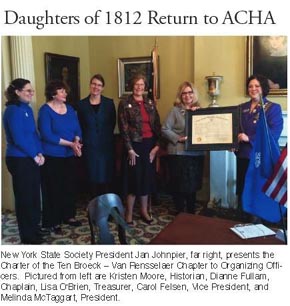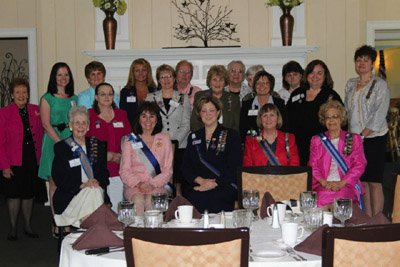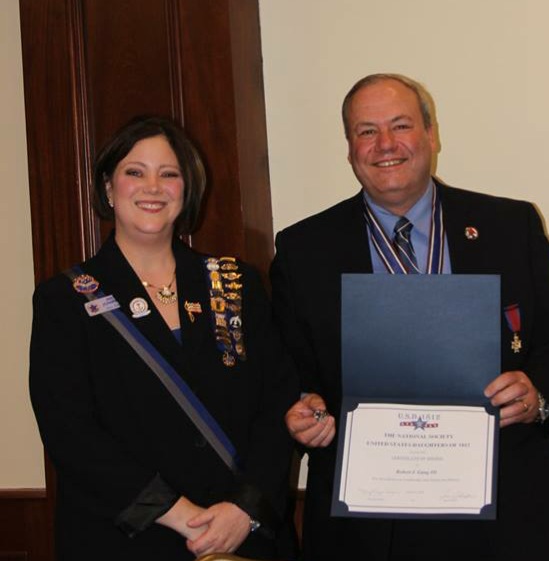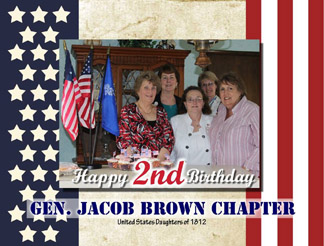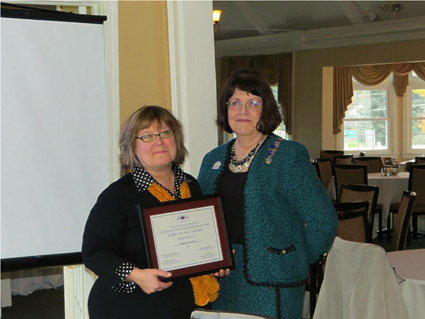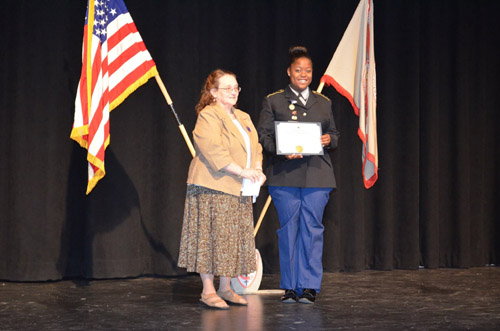 |
||
|---|---|---|
|
STATE REPORTS
|
PP | EditRegion NEW YORK REPORT FOR 2017-2018 CLICK HEREGroup honors War of 1812 veteran with new marker in East PembrokeIncluding two videos Elfreda Strangland, Niagara Frontier, NY Chapter rededicating grave of War of 1812 veteran, Hiram Simpson (descendant Christine Holley of Albuquerque, NM)o
PUBLISHED: MONDAY, OCTOBER 9, 2017 AT 5:15 AM
EAST PEMBROKE — Working on her credentials to join the Daughters of the American Revolution, Christine Holley of Albuquerque found a ancestral link in Genesee County. But it wasn’t the gravestone described in historical records. “We came and looked, and looked, but we couldn’t find them,” Holley said Saturday, as grave markers for her three-times great-grandparents were dedicated with an overwhelming reception. “We came and looked, and looked, but we couldn’t find them,” Holley said Saturday, as grave markers for her three-times great-grandparents were dedicated with an overwhelming reception. With salutes by Genesee County’s Joint Veterans Honor Guard and members of various war veteran ancestry groups, new stones for Hiram S. and Nancy Caslar Simpson were dedicated at Hillside Cemetery. Hiram and Nancy Simpson married in January of 1812, just months before the final conflict of the United States’ birth began. Their country, and their marriage survived, but their final resting place in East Pembroke is considered lost. A number of the graves in the back of the Hillside Cemetery were relocated from an earlier cemetery near Slusser Road, but primitive gravestones for some may have ended up in the bases of barns or weathered away The VA responded to a request by Holley and the National Society United States Daughters of 1812’s Niagara Chapter with a new military headstone and standard for Hiram. The Derrick Monument Company of Le Roy and Ideal Burial Vault Company of Corfu installed both stones, which are located in the Merrill family plot a few feet from the grave of Hiram C. Simpson, a nephew. The reverence for early American patriots and soldiers ran strong Saturday. “Hiram S. Simpson was part of what made America great,” said U.S.D. of 1812 Chapter President Elfreda Strangland, who led the proceedings. Records indicate that Hiram S. Simpson moved westward throughout his youth, from his birthplace near Glens Falls to a childhood in Scipio, and then Troupburg before joining the New York militia. He returned there after action at Fort Erie, Ont., before he, Nancy and seven children are listed as residents of East Pembroke. Despite bounty-land grants in Iowa and Arkansas, the Simpsons stayed in East Pembroke until his death in 1867. Nancy died in 1881, a year after receiving the last allotment from the war’s pension fund for widows. Holley said she believed Andrew D. Simpson, her four-times great-grandfather, was her link to the American Revolution, but piecing together her lineage through Herman Simpson, Hiram’s brother, fell short a generation from Andrew. A recommendation to look for an old family Bible led her right to Hiram. “They were the big surprise in my genealogy,” Holley said. “Sure enough, it was Hiram.” The serendipitous discoveries continued with a Genesee County history book in a New Mexico library, and a photo book whose first entries are tintypes of Nancy and Hiram made shortly before his death. “It’s obvious they were loved and respected,” Holley said, looking at a gathering well beyond her initial hopes. “Thank you, most sincerely, for coming,” she told them. “It’s an honor for him and an honor for me.”
OBSERVER Photo by Gib Snyder The Dunkirk Lighthouse & Veterans Park Museum will be the site of a plaque dedication on Saturday at 2 p.m. honoring War of 1812 heroine Celea Sampson “Widow” Cole. The State of New York Society, United States Daughters of 1812, will dedicate a new plaque in recognition of War of 1812 heroine, Celea Sampson “Widow” Cole on Saturday at 2 p.m. at the Dunkirk Lighthouse & Veterans Park Museum, 1 Lighthouse Point Drive N., Dunkirk. Celea (Sampson) Cole was the wife of Seth Cole, first settler in the Dunkirk area and a Revolutionary War Soldier who had settled at the mouth of Canadaway Creek. Celea was widowed upon his death in 1810. Widow Cole was known for the great courage she displayed during the War of 1812; serving as patrol, spreading the alarm among settlers, feeding the soldiers stationed near her home, as well as melting her pewter dishes and precious teapot to make bullets for their use. The plaque which will be placed by the State of NY Society, U.S. Daughters of 1812 reads: On Sept. 26, 1812 and from this site, some of the first shots of the War of 1812 were fired by local militia at armed soldiers from the British schooner Lady Prevost. When a small boat carrying the soldiers from the British ship was sighted rowing in pursuit of an American salt barge that had taken refuge at the mouth of Canadaway Creek, local citizen Celea Sampson “Widow” Cole rode her horse to the settlement of Canadaway (Fredonia) to secure reinforcements. Recognized as a War of 1812 heroine for her efforts to spread the alarm, the widow Cole reportedly also carried food and water to the militiamen and melted her pewter dishes to make bullets for their use during the attack. (Inscription details were researched by Mary Raye Casper, state historian and 4th vice president national). In recognition of the significant impact made by widow Cole in both the Dunkirk and Fredonia areas in 1812, NY Daughters are inviting the public to join them on the grounds of the Lighthouse for this plaque dedication. The State of NY Society would like to thank David Briska, Dunkirk Lighthouse; Loretta Hill, Newman Brothers; and Linda Blodgett, Titus Monuments; for their assistance with creation of and placement of the plaque. The purposes of the National Society, United States Daughters of 1812 are to promote patriotism; to preserve and increase the knowledge of history of the American people, by the preservation of documents and relics, the marking of historic spots, the recording of family histories and traditions, the celebration of patriotic anniversaries, teaching and emphasizing the heroic deeds of the civil, military and naval life of those who molded the government between the close of the American Revolution and the close of the War of 1812, to urge Congress to compile and publish authentic records of men in civil, military and naval service from 1784-1815, inclusive. Questions about the Dunkirk dedication and/or membership in the 1812 organization may be directed to Beverly Sterling-Affinati at harborsideservices@gmail.com. Mary Raye Casper resides in Marcellus, New York, and has been instrumental in moving the State of NY Society forward through each of its last three administrations. For Resources Pertaining to War of 1812 Soldiers in NY State Click Heree
|

